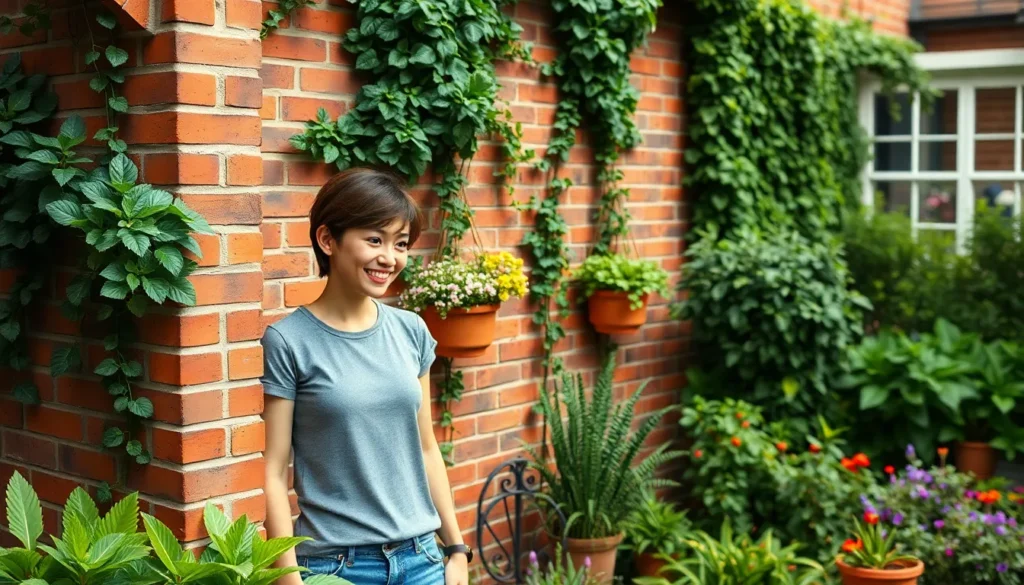When we think about transforming our outdoor spaces, brick walls often become the unsung heroes of garden design. These versatile structures don’t just define boundaries – they create stunning focal points that blend timeless charm with modern functionality.
We’ve discovered that brick walls offer endless possibilities for garden enthusiasts looking to add character and structure to their landscapes. Whether you’re dreaming of a cozy cottage garden vibe or seeking to create dramatic height variations, brick walls deliver both aesthetic appeal and practical benefits that stand the test of time.
From rustic reclaimed brick features to sleek contemporary designs, we’ll explore creative approaches that’ll transform your garden into an outdoor sanctuary. These aren’t just walls – they’re the foundation for vertical gardens, privacy screens, and architectural elements that’ll make your neighbors stop and stare.
Classic Red Brick Garden Wall Designs
Traditional red brick walls remain the foundation of timeless garden design across residential landscapes. We’ve observed these enduring structures create warm, inviting boundaries that complement both cottage gardens and formal outdoor spaces with equal elegance.
Running Bond Pattern Walls offer the most recognizable red brick configuration for garden applications. Staggered joints create visual strength while allowing for proper drainage and structural integrity. These walls typically reach heights between 3 to 6 feet, making them perfect for property boundaries or creating intimate garden rooms within larger landscapes.
Flemish Bond Red Brick Designs showcase alternating headers and stretchers in each course for enhanced visual appeal. This pattern creates subtle texture variations that catch natural light throughout the day. Garden designers frequently specify this technique for feature walls behind seating areas or as backdrops for climbing plants like roses and clematis.
Stack Bond Configuration presents a more contemporary approach using classic red materials. Vertical joints align perfectly to create clean, geometric lines that work exceptionally well in modern garden settings. These walls require additional reinforcement due to the lack of overlapping joints but deliver striking visual impact when combined with ornamental grasses or architectural plantings.
Curved Red Brick Walls soften harsh garden lines while maintaining the classic appeal of traditional materials. We recommend radius walls for creating natural transitions between different garden zones or enclosing circular patios and water features. The curved design requires skilled masonry work but results in flowing, organic shapes that enhance industry movement.
Double Wythe Construction provides substantial presence for larger garden installations requiring maximum durability. These thick walls incorporate two parallel brick layers with proper tie courses for structural stability. Garden walls built using this method easily support integrated planters, lighting fixtures, or decorative coping stones while withstanding decades of weather exposure.
Modern Minimalist Brick Wall Concepts
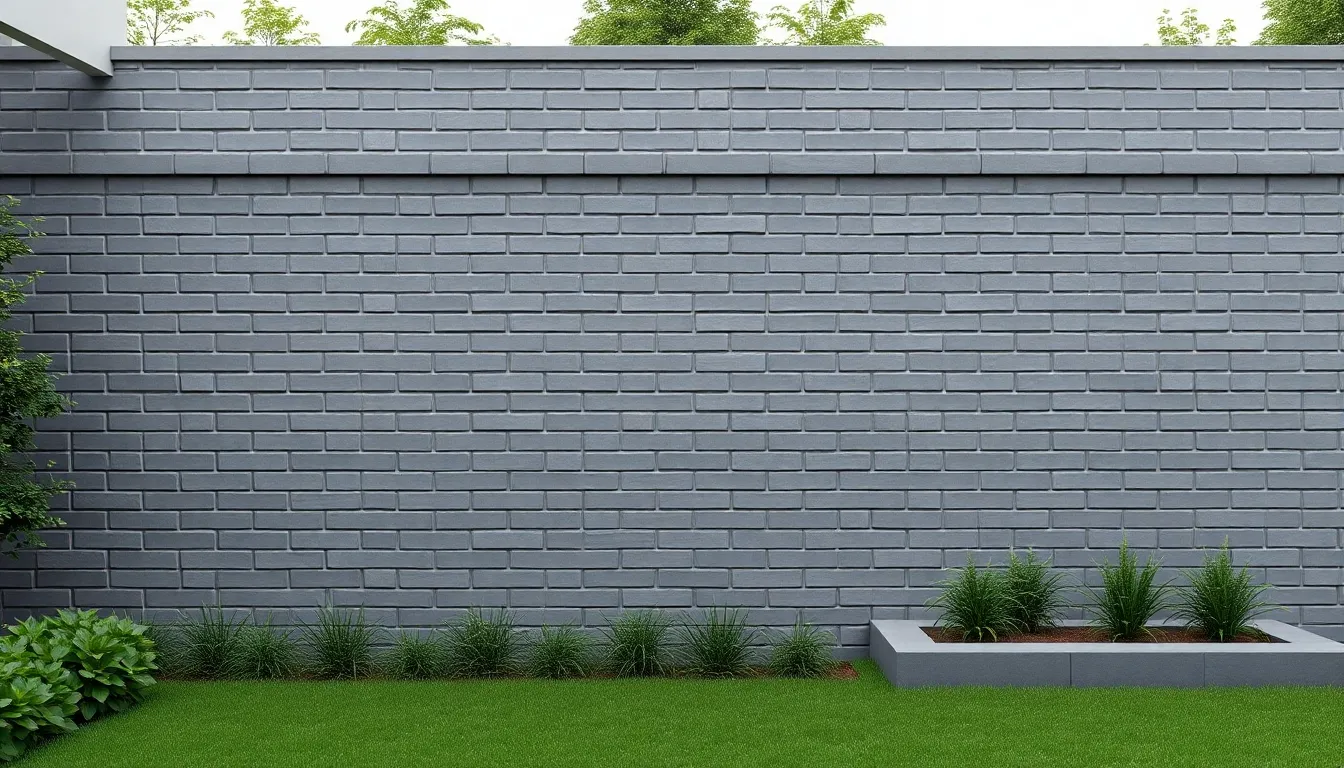
Modern minimalist garden brick walls prioritize simplicity and functionality while maintaining sophisticated aesthetics. These contemporary designs create striking focal points that complement clean outdoor spaces.
Clean Lines and Geometric Patterns
Minimalist brick walls emphasize straight, unbroken lines that create powerful visual impact in garden spaces. Stack bond patterns place bricks directly on top of each other, forming smooth surfaces that enhance the wall’s geometric appeal. Stretcher bond configurations stagger each course by half a brick, creating precise patterns that maintain clean aesthetics.
Sharp edges on parapets and stepped designs amplify the geometric nature of these structures. We avoid rounded or serpentine patterns that might compromise the minimalist approach. Straight vertical lines and horizontal coursing work together to establish strong architectural presence in garden settings.
Precise brick placement ensures consistent spacing and alignment throughout the installation. These geometric patterns create visual strength while supporting the wall’s structural integrity. Clean execution of these patterns transforms simple brick walls into sophisticated design elements.
Monochromatic Color Schemes
Single color palettes define modern minimalist brick wall designs, creating cohesive visual impact. Gray, black, and white bricks deliver subdued appearances that complement contemporary garden aesthetics. Red brick maintains its natural warmth while fitting seamlessly into minimalist design frameworks.
Matching grout colors to brick tones creates seamless, monolithic appearances that enhance the wall’s unified look. We select mortar that blends rather than contrasts, ensuring the wall appears as one continuous surface. This technique eliminates visual interruptions that might detract from the minimalist aesthetic.
Consistent color application throughout the garden space reinforces the design’s sophisticated simplicity. Monochromatic schemes allow other garden elements like plants and hardscaping to become focal points. These restrained color choices create timeless appeal that won’t clash with changing industry trends.
Decorative Brick Wall Features for Gardens

We’ve seen how minimalist designs focus on clean lines, but decorative brick walls offer endless opportunities to add functional beauty to our garden spaces. These enhanced features transform ordinary boundaries into multifunctional elements that serve both practical and aesthetic purposes.
Integrated Planters and Garden Beds
Custom shaped planters constructed from bricks create seamless connections between our walls and growing spaces. We can design geometric planters as squares or rectangles for structured herb gardens, or choose creative circular and spiral configurations for eye catching flower displays. These integrated planters house everything from colorful annuals to hardy succulents, blending our growing spaces with structural elements naturally.
Raised garden beds tied to existing walls using matching brick materials visually unify our garden design while creating clear divisions between lawn and patio areas. We can extend our wall height to accommodate deeper soil for vegetables and perennials, maximizing growing space without compromising the cohesive aesthetic. The continuous brick material creates a sophisticated look that connects all our garden’s architectural elements.
Vertical growing pockets built into brick walls provide additional planting opportunities without requiring extra ground space. We position these strategic openings at varying heights to create living walls that showcase trailing plants like ivy or colorful cascading flowers throughout our garden seasons.
Built-In Seating Areas
Brick benches integrated into our garden walls create permanent seating that matches our industry’s architectural style perfectly. We can design these solid seating areas at comfortable heights around rest spots or social gathering spaces, eliminating the need for separate outdoor furniture that requires seasonal storage or replacement.
Extended wall caps provide natural seating ledges that complement our brick construction while offering casual perching spots throughout the garden. We can add cushions or weather resistant padding during entertaining seasons, then remove them for easy maintenance during winter months.
Corner seating nooks created by intersecting brick walls establish intimate conversation areas that feel naturally carved into our garden’s layout. These built in features provide windbreak protection while creating cozy spaces that encourage outdoor relaxation and social connection.
Artistic Brick Patterns and Textures
Herringbone and basket weave patterns add decorative surfaces to our garden walls that catch light differently throughout the day. We can incorporate these intricate designs as accent sections within larger wall spans, creating visual interest without overwhelming our overall garden aesthetic.
Brick arches and pergola structures at garden entrances serve as dramatic architectural statements while supporting climbing plants like wisteria and jasmine for enchanting seasonal displays. These curved elements soften the rigid lines of our boundary walls while creating natural frames for garden views and pathways.
Textured finishes using reclaimed or specialty bricks introduce unique character that complements both rustic and formal garden styles. We can alternate smooth and rough textured bricks to create subtle pattern variations, or incorporate bricks with different surface treatments to add depth and visual complexity to our garden walls.
Functional Garden Brick Wall Solutions
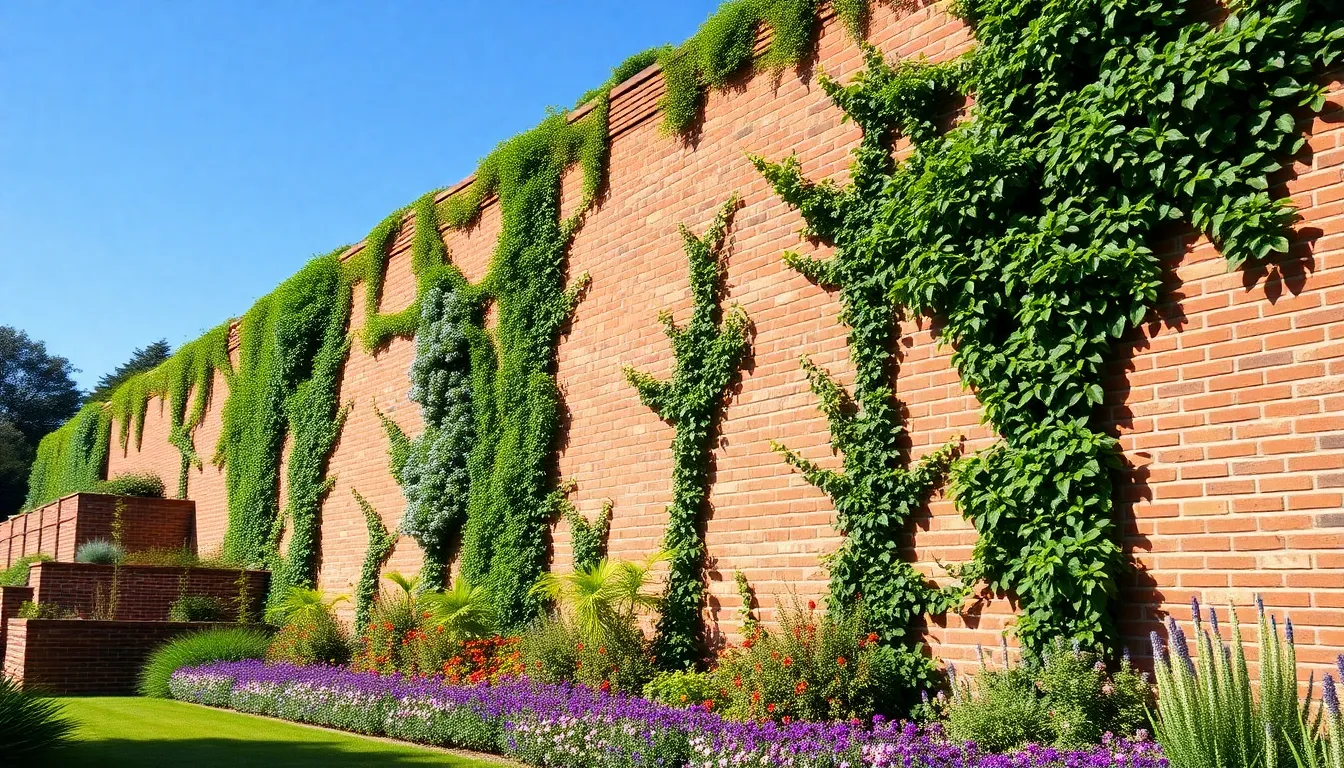
Beyond their decorative appeal, garden brick walls serve essential practical functions that enhance outdoor living spaces while addressing common landscaping challenges.
Privacy Screening Walls
Tall brick walls create effective privacy barriers that block unwanted views from neighboring properties while establishing clear boundaries. We recommend constructing walls between 6-8 feet high for optimal privacy screening without overwhelming smaller garden spaces.
Decorative elements enhance both privacy and visual appeal when you incorporate climbing plants like ivy, clematis, or jasmine into the wall design. These natural additions soften the brick’s rigid lines while providing extra screening density.
Strategic placement maximizes privacy benefits by positioning walls along property lines or around outdoor seating areas. Consider adding lattice work or trellis sections at the top of shorter walls to increase height while maintaining an open feeling.
Retaining Wall Applications
Sloped gardens benefit significantly from brick retaining walls that provide essential structural support while preventing soil erosion on uneven terrain. These walls can transform challenging slopes into usable terraced spaces perfect for planting or entertaining.
Multi level gardens create visual interest through stepped brick walls that establish distinct elevation zones throughout your outdoor space. Each level can serve different purposes, from herb gardens at eye level to decorative flower beds at ground level.
Proper drainage considerations ensure long term stability when constructing retaining walls. We recommend incorporating drainage pipes and gravel backfill behind walls over 3 feet high to prevent water buildup and structural damage.
Wind Protection Barriers
Solid brick walls act as effective windbreaks that shield delicate plants and outdoor furniture from harsh weather conditions. These barriers can reduce wind speed by up to 50% within a protected zone extending 10 times the wall’s height.
Strategic wall placement creates microclimates that allow you to grow more sensitive plants in areas that would otherwise be too exposed. Position walls perpendicular to prevailing winds for maximum protection coverage.
Decorative gaps and patterns maintain airflow while still providing wind protection through thoughtfully designed openings. Consider incorporating brick screen patterns or alternating solid and open sections to balance protection with ventilation needs.
Creative Brick Wall Height Variations
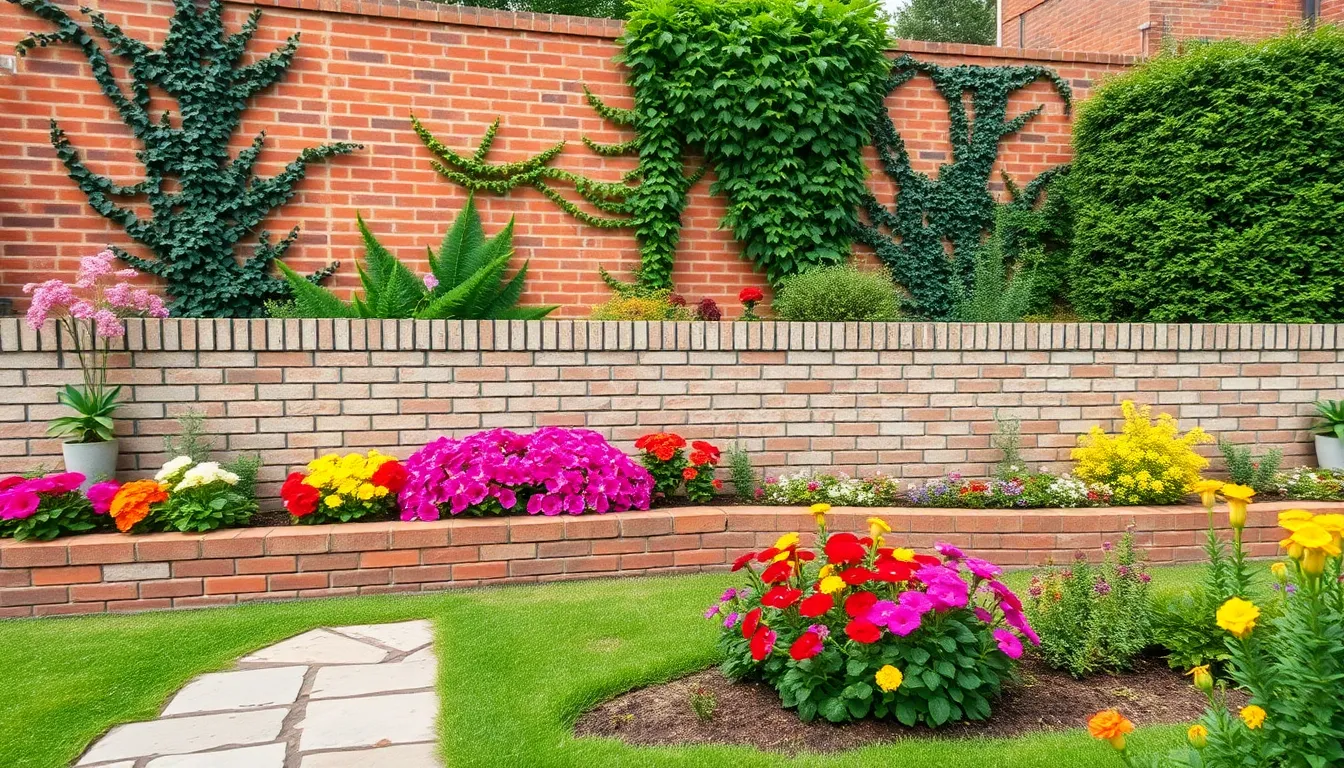
Strategic height planning transforms brick walls from simple boundaries into ever-changing design elements that define garden spaces and create visual hierarchy.
Low Border Walls for Pathways
Low border walls serve as gentle separators between different garden zones, creating natural transitions from seating areas to vegetable patches. We recommend building these walls at 12-18 inches high to maintain visual flow while establishing clear boundaries. Pathways benefit significantly from low brick borders that guide foot traffic and prevent erosion along garden beds.
Sloped gardens particularly benefit from low retaining walls that provide essential structure and soil support. These shorter walls prevent runoff while creating level planting areas for flowers and herbs. Garden designers often incorporate curved low walls to soften harsh lines and create organic flow throughout industry spaces.
Medium Height Accent Walls
Medium height accent walls at 2-4 feet create perfect backdrops for featured plants while maintaining open sight lines across garden areas. We’ve found these walls work exceptionally well as dividers between lawn spaces and patio entertaining areas. Visual interest increases dramatically when medium walls incorporate varied textures like basket weave or herringbone patterns.
Plant enthusiasts love medium walls because they provide wind protection for delicate flowers without blocking sunlight completely. These accent features can frame outdoor seating areas while creating intimate garden rooms within larger landscapes. Strategic placement of medium walls helps establish focal points that draw attention to water features or sculpture displays.
Tall Statement Walls
Tall statement walls reaching 6-8 feet create dramatic garden entrances and provide substantial privacy screening from neighboring properties. We design these impressive structures to support climbing plants like ivy and roses, transforming plain brick surfaces into living green walls. Privacy becomes achievable without sacrificing beauty when tall walls incorporate decorative elements and varied textures.
Architectural impact increases significantly with tall brick walls that serve as backdrops for other garden features like fountains or outdoor art installations. These substantial structures can incorporate built-in planters at their base, creating layered planting opportunities that maximize vertical growing space. Wind protection for entire garden sections becomes possible with strategically positioned tall walls that create beneficial microclimates for sensitive plants.
Mixed Material Brick Wall Ideas

Combining brick with complementary materials creates stunning garden walls that offer enhanced visual appeal and structural versatility. These mixed material approaches allow us to blend different textures and colors for truly unique industry features.
Brick and Stone Combinations
Alternating layers of brick and natural stone create visually striking walls that maximize both durability and aesthetic impact. We can design these combinations using stone for accent sections or coping elements, which provides excellent texture contrast against traditional brickwork. Stone accents work particularly well in retaining walls where the natural material’s hardness complements brick’s structural integrity.
Natural stone coping transforms standard brick walls into premium industry features that resist weathering while adding rustic charm. These combinations excel in garden divider applications where we need both functional barriers and attractive design elements. Stone and brick partnerships create walls that seamlessly blend with existing industry materials like gravel paths or rock gardens.
Brick with Wood Accents
Dark stained wood posts positioned between brick columns create contemporary garden walls that blend warmth with structural strength. We can incorporate horizontal wooden planks directly into brickwork sections, producing modern industry features that stand out in residential settings. Wood accents provide essential contrast against brick’s uniform surface while maintaining the wall’s overall structural integrity.
Horizontal wood integration offers versatility for various garden styles, from contemporary outdoor spaces to transitional industry designs. These mixed material walls work exceptionally well as backdrop features for plant displays or seating areas. Wood elements soften brick’s industrial appearance while adding natural warmth that complements surrounding vegetation.
Metal and Brick Integration
Metal panel integration alongside brick sections creates industrial aesthetic walls perfect for modern and minimalist garden designs. We can use metal edging or decorative panels to break up large brick expanses, producing contemporary features that serve as striking focal points. Metal develops attractive rusted patina over time, adding character and uniqueness to garden walls.
Contemporary metal accents transform traditional brick walls into standout industry features that complement modern outdoor living spaces. These combinations work particularly well in gardens seeking industrial or urban design elements. Metal and brick partnerships create walls that bridge traditional masonry with contemporary materials, offering durability while maintaining cutting edge visual appeal.
Curved and Shaped Brick Wall Designs
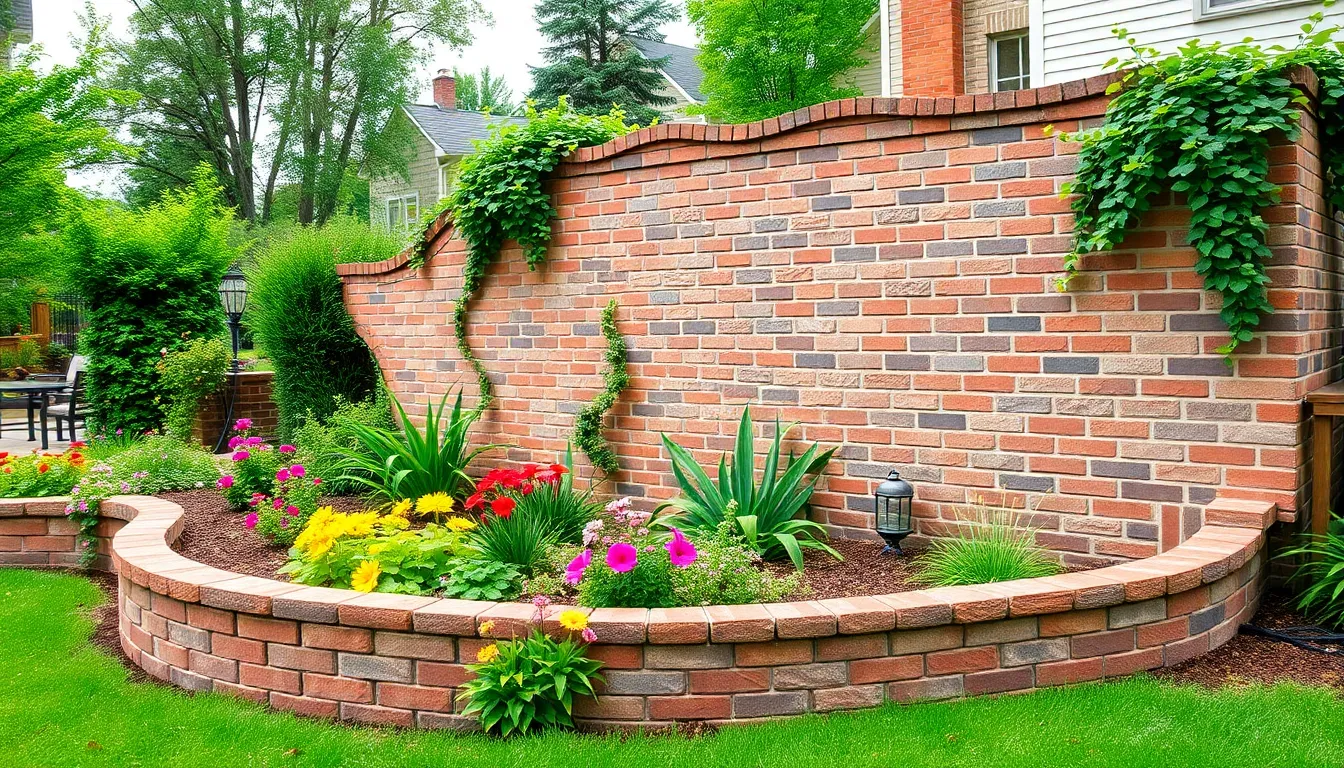
Curved brick walls introduce ever-changing movement to garden spaces, breaking away from traditional straight line designs while offering unique structural advantages.
Serpentine Garden Walls
Serpentine walls create stunning wavy patterns that combine visual appeal with exceptional engineering benefits. These crinkle crankle walls follow a serpentine path, providing remarkable strength against lateral forces without requiring additional buttresses.
We love how these undulating structures use less material compared to straight walls, making them an economical choice for garden projects. The curved design naturally traps and radiates sunlight, creating beneficial microclimates that support plant growth, particularly for fruit bearing varieties.
Building serpentine walls requires careful planning to achieve the proper wave pattern while maintaining structural integrity. The serpentine design distributes weight evenly across the curved sections, resulting in walls that can withstand wind and weather conditions more effectively than traditional straight constructions.
Circular and Rounded Features
Circular brick features transform gardens into inviting spaces with their flowing, organic shapes. These rounded elements work perfectly as focal points, creating natural gathering areas for seating arrangements or serving as distinctive planters.
We find that circular brick constructions offer versatility in garden design, allowing for creative integration with existing industry features. The curved brick capping on these structures provides a finished appearance while improving color and texture variations throughout the space.
Rounded brick features can vary in size and purpose, from small circular planters to large seating walls that encourage social interaction. The continuous curves create visual continuity with surrounding industry elements, softening the hard edges typically associated with masonry construction.
These circular designs work exceptionally well in both formal and informal garden settings, adapting to different design aesthetics while maintaining their distinctive character. The durability of brick construction ensures these rounded features will remain beautiful garden anchors for years to come.
Lighting Integration in Brick Garden Walls
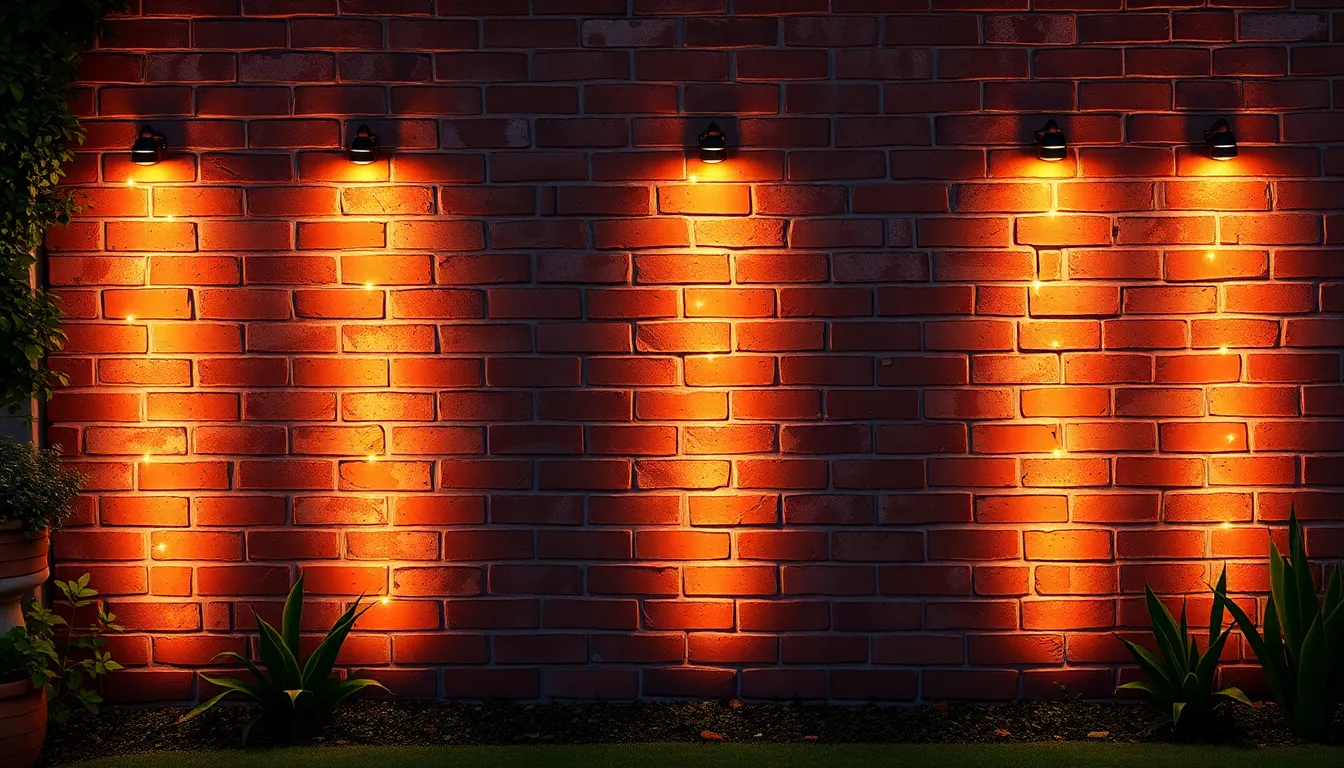
Lighting transforms garden brick walls from simple barriers into stunning nighttime focal points. Strategic illumination highlights textures and creates inviting outdoor atmospheres that extend usability well into evening hours.
Built-In LED Strip Lighting
Built-in LED strip lighting creates modern and sleek appearances when embedded directly within brickwork. We recommend installing these strips along the top or bottom edges of walls to accentuate their architectural lines and create dramatic shadow effects.
Installing LED strips requires careful planning during construction phases to ensure proper electrical connections and weatherproofing. Recessed channels built into mortar joints hide wiring while protecting fixtures from moisture damage. These strips work particularly well with clean lined contemporary brick walls where minimal design elements enhance sophisticated aesthetics.
Color temperature selection affects the overall ambiance of your garden space. Warm white LEDs (2700K-3000K) complement traditional red brick tones and create cozy evening environments. Cool white options (4000K-5000K) pair beautifully with gray or charcoal brick walls in modern industry designs.
Smart LED systems allow remote control and programmable timing features that automatically adjust brightness levels throughout different seasons. Integration with home automation systems enables coordination with other outdoor lighting elements for cohesive industry illumination.
Accent Lighting Options
Accent lighting highlights exact features and architectural details within garden brick wall designs. Solar powered spotlights offer energy efficient answers that eliminate complex wiring requirements while providing focused illumination on textured surfaces or decorative patterns.
Wall mounted fixtures create warm pools of light that emphasize brick textures and mortar lines. Up lighting techniques cast dramatic shadows across wall surfaces while down lighting provides subtle pathway illumination along garden borders. Strategic placement prevents harsh glare while maximizing visual impact.
Industry lighting systems integrate seamlessly with existing garden features like raised beds and water elements. Low voltage options ensure safety around moisture prone areas while maintaining sufficient brightness for evening enjoyment. Timer controls optimize energy usage and extend fixture lifespan.
Decorative lantern styles complement traditional garden aesthetics while providing functional illumination for seating areas and walkways. These fixtures mount directly to brick surfaces using masonry anchors that distribute weight evenly across multiple brick units.
Budget-Friendly Brick Wall Alternatives
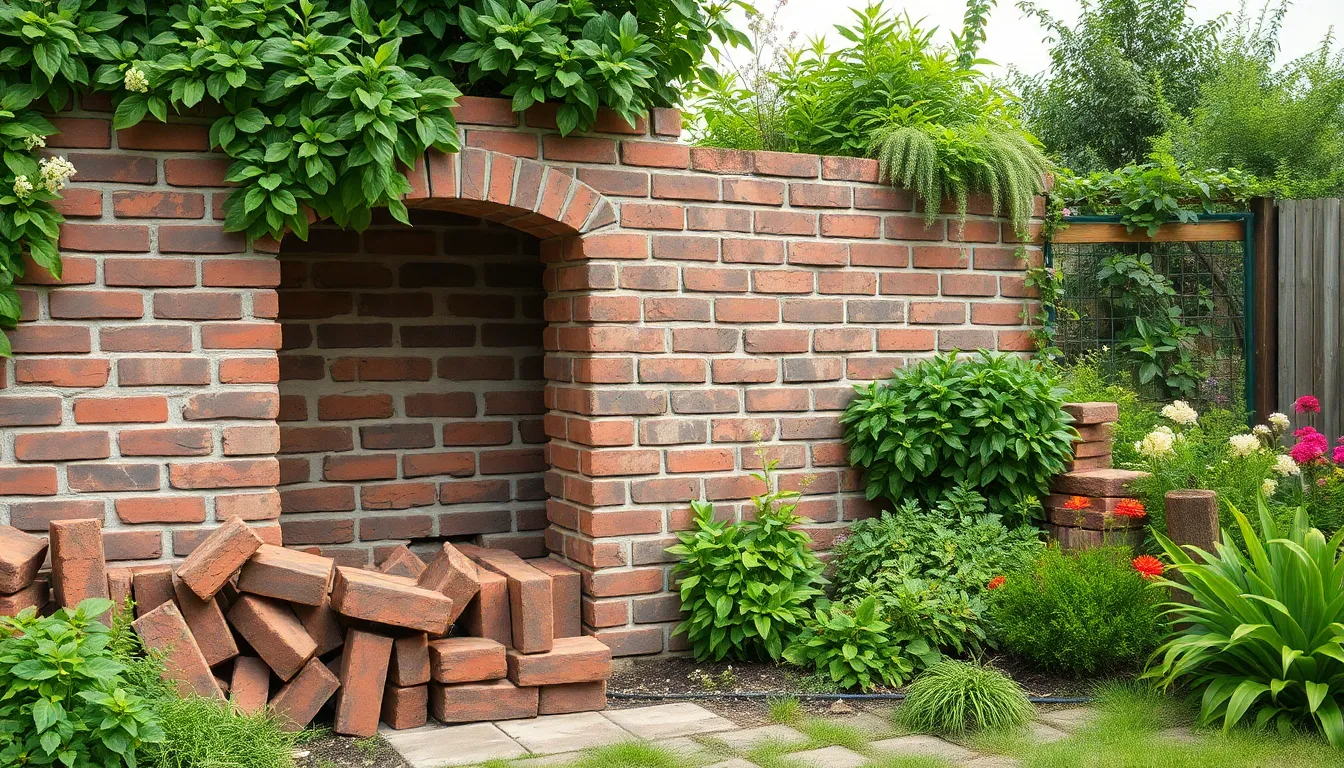
Creating beautiful garden brick walls doesn’t have to drain your budget. Smart alternatives and strategic planning can help you achieve the same stunning results for significantly less money.
Reclaimed Brick Options
Salvaged bricks from old buildings offer the most cost-effective solution for budget-conscious gardeners. Construction sites and demolition projects frequently discard quality bricks that you can collect with permission from contractors or property owners.
Second-hand stores like Habitat for Humanity ReStores provide affordable options with consistent pricing and quality assurance. These retail locations often stock architectural salvage including various brick types and quantities suitable for garden wall projects.
Online marketplaces and community boards connect you directly with people selling or giving away reclaimed bricks. Facebook Marketplace, Craigslist, and NextDoor frequently feature listings from homeowners completing renovation projects who need to dispose of surplus materials.
Brick pavers from old walkways can be repurposed into attractive wall installations while serving dual functions. These materials typically cost 30-50% less than new bricks and often feature interesting weathered characteristics that add instant character to your garden design.
Brick veneer panels provide the authentic brick appearance without the structural complexity or full material costs. These lightweight alternatives install quickly over existing walls or frames and create convincing visual impact for a fraction of traditional brick wall expenses.
DIY Installation Tips
Planning your wall layout prevents costly mistakes and ensures you have adequate materials before beginning construction. Measure the intended area carefully and sketch your design including any curves, height variations, or integrated features like planters or seating areas.
Leveling the ground properly creates the stable foundation essential for long-lasting brick walls. Use a level tool to check the base area and add sand or gravel as needed to create an even surface that prevents future settling or structural issues.
Applying mortar between bricks requires consistent technique to achieve professional-looking results. Mix small batches to prevent waste and use a level frequently to maintain straight lines throughout your installation process.
Starting with corner sections helps establish proper alignment for the entire wall structure. Build up corners first, then fill in the middle sections using string lines to maintain consistent height and straightness across longer wall runs.
Checking vertical alignment regularly prevents leaning walls that compromise structural integrity. Use a plumb line or level every few courses to ensure your wall remains perfectly vertical as you build upward.
Conclusion
Transform your garden into an extraordinary outdoor sanctuary with the perfect brick wall design that matches your vision and budget. We’ve explored countless possibilities from classic red brick configurations to modern minimalist approaches that create stunning focal points in any industry.
Whether you’re seeking privacy screening tall statement walls or charming low borders that define garden zones the versatility of brick construction offers endless creative potential. Mix materials like stone and wood or incorporate curved serpentine designs to add unique character that sets your space apart.
Don’t let budget constraints limit your dreams – reclaimed bricks and DIY installation techniques make beautiful garden walls accessible to every homeowner. With proper planning and strategic lighting integration your brick wall investment will enhance both the functionality and nighttime appeal of your outdoor living space for years to come.
Frequently Asked Questions
What are the main benefits of using brick walls in garden design?
Brick walls serve dual purposes as functional boundaries and striking focal points in gardens. They offer versatility in design, from creating cozy cottage feels to dramatic height variations. Brick walls can function as privacy screens, retaining walls for sloped areas, wind barriers, and vertical gardens while adding timeless aesthetic appeal to outdoor spaces.
What are the most popular brick wall patterns for gardens?
The most popular brick patterns include Running Bond (offset rows), Flemish Bond (alternating headers and stretchers), and Stack Bond (aligned joints). Herringbone patterns add decorative appeal, while curved configurations create visual interest. Each pattern offers different aesthetic and structural benefits depending on your garden’s style and functional needs.
How tall should garden brick walls be for different purposes?
Low border walls (12-18 inches) work as gentle separators between garden zones. Medium accent walls (2-4 feet) create plant backdrops while maintaining sight lines. Tall statement walls (6-8 feet) provide maximum privacy and dramatic entrances. Height choice depends on your specific needs for privacy, aesthetics, and local building codes.
Can I combine brick with other materials in garden walls?
Yes, mixing brick with stone, wood, and metal creates stunning visual appeal and structural versatility. Brick-stone combinations offer durability, while wood accents add warmth and contrast. Metal panels create contemporary features that bridge traditional masonry with modern design, making mixed-material walls suitable for various garden styles.
What are budget-friendly alternatives to new brick walls?
Reclaimed bricks from old buildings and second-hand stores offer cost-effective solutions. Brick pavers from old walkways and brick veneer panels provide affordable alternatives while maintaining authentic appearance. DIY installation can significantly reduce costs, though proper planning, ground leveling, and alignment are crucial for professional-looking results.
How can I incorporate lighting into my brick garden walls?
Built-in LED strip lighting can be embedded within brickwork for modern appearances and dramatic shadow effects. Solar-powered spotlights and wall-mounted fixtures enhance brick textures and architectural details. Decorative lanterns provide functional illumination while complementing traditional aesthetics. Proper electrical planning and weatherproofing are essential during installation.
What are the advantages of curved brick walls over straight ones?
Curved brick walls introduce movement and visual interest while offering structural advantages. Serpentine walls use less material than straight walls and create beneficial microclimates for plants. Circular features serve as focal points and adapt well to various garden aesthetics, providing durability and creating inviting spaces for seating or planters.
How do brick walls help with practical garden functions?
Brick walls excel at privacy screening, blocking unwanted views while supporting climbing plants. As retaining walls, they support sloped gardens and prevent soil erosion. They also serve as effective windbreaks, creating protected microclimates for sensitive plants and enhancing growing conditions in exposed garden areas.

